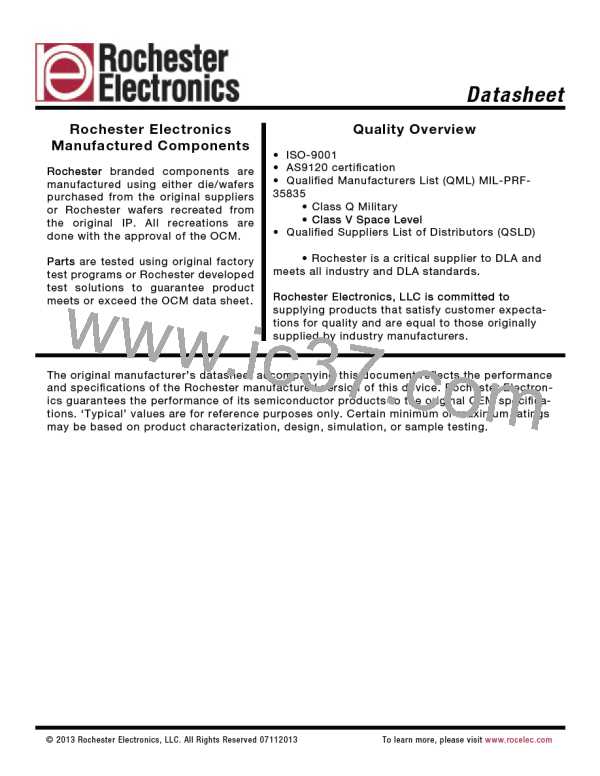AD7656-1/AD7657-1/AD7658-1
TERMINOLOGY
Data Sheet
Total Harmonic Distortion (THD)
Integral Nonlinearity (INL)
The ratio of the rms sum of the harmonics to the fundamental.
For the AD7656-1/AD7657-1/AD7658-1, it is defined as
The maximum deviation from a straight line passing through
the endpoints of the ADC transfer function. The endpoints of
the transfer function are zero scale at a ½ LSB below the first code
transition and full scale at ½ LSB above the last code transition.
2
2
2
2
2
V2 +V3 +V4 +V5 +V6
THD (dB) = 20 log
V1
Differential Nonlinearity (DNL)
The difference between the measured and the ideal 1 LSB
change between any two adjacent codes in the ADC.
where:
V1 is the rms amplitude of the fundamental.
V2, V3, V4, V5, and V6 are the rms amplitudes of the second
Bipolar Zero Scale Error
The deviation of the midscale transition (all 1s to all 0s) from
the ideal VIN voltage, that is, AGND − 1 LSB.
through sixth harmonics.
Peak Harmonic or Spurious Noise
The ratio of the rms value of the next largest component in the
ADC output spectrum (up to fSAMPLE/2, excluding dc) to the rms
value of the fundamental. Normally, the value of this specification
is determined by the largest harmonic in the spectrum, but for
ADCs where the harmonics are buried in the noise floor, it is
determined by a noise peak.
Bipolar Zero Scale Error Matching
The difference in bipolar zero code error between any two input
channels.
Positive Full-Scale Error
The deviation of the last code transition (011 … 110 to 011 … 111)
from the ideal (+4 × VREF − 1 LSB, +2 × VREF − 1 LSB) after
adjusting for the bipolar zero scale error.
Intermodulation Distortion (IMD)
With inputs consisting of sine waves at two frequencies, fa and
fb, any active device with nonlinearities create distortion
products at the sum and difference frequencies of mfa nfb,
where m, n = 0, 1, 2, 3. Intermodulation distortion terms are
those for which neither m nor n are equal to 0. For example, the
second-order terms include (fa + fb) and (fa − fb), and the
third-order terms include (2fa + fb), (2fa − fb), (fa + 2fb), and
(fa − 2fb).
Positive Full-Scale Error Matching
The difference in positive full-scale error between any two input
channels.
Negative Full-Scale Error
The deviation of the first code transition (10 … 000 to 10 … 001)
from the ideal (−4 × VREF + 1 LSB, −2 × VREF + 1 LSB) after
adjusting for the bipolar zero scale error.
The AD7656-1/AD7657-1/AD7658-1 are tested using the CCIF
standard in which two input frequencies near the maximum
input bandwidth are used. In this case, the second-order terms
are usually distanced in frequency from the original sine waves,
and the third-order terms are usually at a frequency close to the
input frequencies. As a result, the second- and third-order terms
are specified separately. The calculation of the intermodulation
distortion is per the THD specification, where it is the ratio of
the rms sum of the individual distortion products to the rms
amplitude of the sum of the fundamentals and is expressed in
decibels.
Negative Full-Scale Error Matching
The difference in negative full-scale error between any two
input channels.
Track-and-Hold Acquisition Time
The track-and-hold amplifier returns to track mode at the end
of the conversion. The track-and-hold acquisition time is the
time required for the output of the track-and-hold amplifier to
reach its final value, within 1 LSB, after the end of the conversion.
See the Track-and-Hold section for more details.
Signal-to-(Noise + Distortion) Ratio (SINAD)
The measured ratio of signal-to-(noise + distortion) at the
output of the ADC. The signal is the rms amplitude of the
fundamental. Noise is the sum of all nonfundamental signals up
to half the sampling frequency (fSAMPLE/2, excluding dc).
Channel-to-Channel Isolation
Channel-to-channel isolation is a measure of the level of crosstalk
between any two channels. It is measured by applying a full-scale,
100 kHz sine wave signal to all unselected input channels and
determining the degree to which the signal attenuates in the
selected channel with a 30 kHz signal.
The ratio depends on the number of quantization levels in the
digitization process: the more levels, the smaller the quantization
noise. The theoretical SINAD ratio for an ideal N-bit converter
with a sine wave input is given by
Power Supply Rejection (PSR)
Variations in power supply affect the full-scale transition but
not the linearity of the converter. Power supply rejection is the
maximum change in the full-scale transition point due to a
change in power supply voltage from the nominal value. See the
Typical Performance Characteristics section.
SINAD = (6.02 N + 1.76) dB
Therefore, SINAD is 98 dB for a 16-bit converter, 86.04 dB for a
14-bit converter, and 74 dB for a 12-bit converter.
Rev. D | Page 18 of 32

 ROCHESTER [ Rochester Electronics ]
ROCHESTER [ Rochester Electronics ]